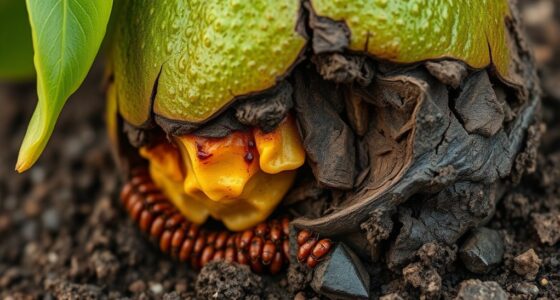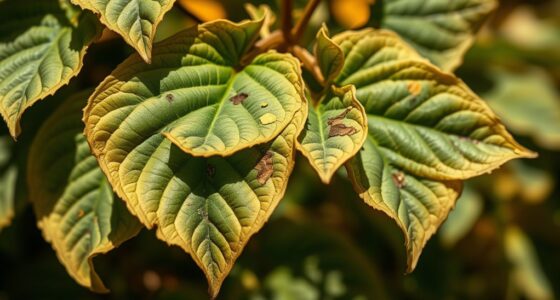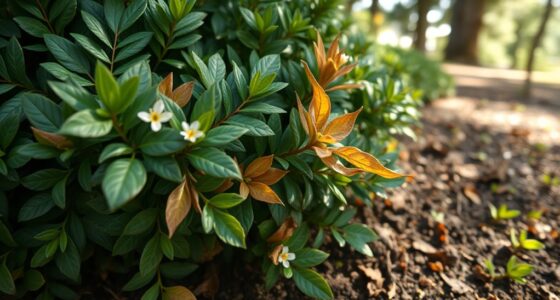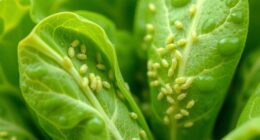If your Acer Palmatum ‘Oridono Nishiki’ is losing its vibrant variegation or suffering from sunburn, it’s likely due to improper care or too much direct sunlight. Make certain you place it in filtered or morning sun, avoid over-fertilizing, and maintain consistent watering. Pruning damaged branches and improving soil health can help restore its health. Keep exploring these tips further to protect your maple’s beauty and energy.
Key Takeaways
- Variegation loss is often caused by environmental stress, improper watering, or nutrient deficiencies, especially iron, magnesium, or manganese.
- Excessive direct sunlight can lead to sunburn, causing leaf scorch, browning edges, and tissue damage.
- Protect ‘Oridono Nishiki’ by placing it in filtered or morning sun to prevent stress and maintain vibrant variegation.
- Regularly monitor soil moisture, avoid over-fertilizing, and prune damaged branches to promote healthy, variegated foliage.
- Signs of sunburn include discoloration, browning tips, leaf crisping, and wilting, requiring prompt shading or environmental adjustments.
Understanding the Causes of Variegation Loss in ‘Oridono Nishiki

Variegation loss in Acer Palmatum ‘Oridono Nishiki’ often occurs due to environmental stresses and improper care. When your tree faces inconsistent watering or temperature fluctuations, the leaf variegation can fade or disappear entirely. Nutrient deficiencies, especially lacking iron, magnesium, or manganese, can also cause the variegated foliage to turn more green, diluting its vibrant pattern. If your plant isn’t getting balanced fertilization, it may struggle to maintain its distinctive leaf coloration. Over-fertilizing or using the wrong type of fertilizer can worsen the problem. To keep the variegation intact, confirm your tree receives proper nutrients and avoid sudden environmental changes. Healthy, well-nourished plants are less likely to experience loss of leaf variegation due to deficiencies or stress. Proper fertilization and maintaining consistent environmental conditions are key to preserving the vibrant variegation in ‘Oridono Nishiki’. Regularly monitoring soil nutrient levels can help prevent deficiencies that lead to variegation loss. Ensuring the plant’s healthy growth requires attention to both environmental and nutritional factors.
How Sunlight Affects the Foliage and Overall Health

Proper lighting is essential for maintaining the vibrant foliage and overall health of your Acer Palmatum ‘Oridono Nishiki’. Adequate sunlight exposure helps enhance leaf pigmentation, giving your tree its characteristic variegated appearance. Too little light can cause the variegation to fade, leading to duller leaves and weaker growth. Conversely, too much direct sun can stress the foliage, resulting in sunburn and leaf scorch. Striking the right balance guarantees the leaves stay colorful and healthy. Keep in mind that this cultivar prefers filtered or morning sun, which provides enough light without risking damage. Regularly monitor your tree’s response to sunlight, adjusting its placement if you notice signs of stress. Proper sunlight management keeps your ‘Oridono Nishiki’ vibrant and thriving. Additionally, understanding the importance of natural materials like wood and linen can help create an optimal environment for your tree’s growth and care routines. Ensuring proper light conditions is crucial for the development of healthy, colorful foliage.
Recognizing Symptoms of Sunburn and Damage

You’ll notice sunburn symptoms on your Acer Palmatum ‘Oridono Nishiki’ as discoloration or browning on the leaves. Wilting and crisping also signal the plant has been overexposed to too much sun. Recognizing these signs early helps you take action to protect your tree. Additionally, understanding the importance of proper disposal practices can help prevent environmental stressors that may exacerbate plant damage. Proper watering techniques, such as using self watering plant pots, can ensure consistent moisture levels and reduce the risk of stress from drought or overwatering. Monitoring your tree regularly for signs of illness or injury ensures timely intervention to maintain its health.
Discoloration and Browning
Discoloration and browning on Acer Palmatum ‘Oridono Nishiki’ often signal sunburn or environmental damage. You may notice leaf discoloration, where the vibrant variegation fades to dull or yellowish tones. Foliage browning typically appears along leaf margins or tips, indicating stress from excessive sun exposure. These symptoms usually develop quickly during hot, sunny days, especially if the plant is suddenly exposed to full sun after being in shade. The affected leaves might feel dry or papery, losing their turgor. Recognizing these signs early helps you take action, such as providing shade or adjusting watering routines. Addressing sunburn promptly can prevent further damage and preserve the plant’s overall health and vibrant appearance.
Leaf Wilting and Crisping
When Acer Palmatum ‘Oridono Nishiki’ suffers from sunburn or environmental stress, leaf wilting and crisping are common warning signs. You’ll notice leaves curling, turning brown at the edges, and becoming brittle. These symptoms often indicate leaf damage due to excessive sun exposure or pests that cause stress. Recognizing these signs early helps prevent further decline. Here’s a quick comparison:
| Symptom | Cause |
|---|---|
| Leaf curling | Pest infestation or dehydration |
| Leaf crisping | Sunburn or nutrient deficiency |
| Wilting | Water stress or root damage |
| Browning edges | Excessive sun or dry conditions |
| Damage spots | Pests or fungal infection |
Promptly address the issue to protect your tree’s health and prevent lasting damage. Proper care includes monitoring environmental conditions and understanding the signs of stress to ensure the health of your Acer Palmatum ‘Oridono Nishiki’. Additionally, understanding the environmental factors that contribute to stress can help you take preventative measures before severe damage occurs.
Proper Placement and Growing Conditions to Prevent Sunburn

To prevent sunburn, you should place your maple in a shady spot where it’s protected from harsh afternoon sun. Keep the soil consistently moist, so the roots don’t dry out or become stressed. Proper placement and watering are key to maintaining healthy growth and vibrant foliage. Additionally, understanding the cost factors involved in proper care can help you allocate resources effectively. Recognizing the importance of privacy policies can also ensure you manage your site’s data responsibly. Incorporating cultural intelligence principles can help you adapt these practices effectively across different environments and climates.
Shady Location Preference
Acer Palmatum ‘Oridono Nishiki’ thrives best in shaded locations where direct sunlight is limited, as intense sun exposure can cause leaf scorch and fading of its variegated foliage. To maintain its health, use pruning techniques to remove damaged or overly exposed branches, encouraging better light distribution and airflow. Incorporate soil amendments like organic compost to improve soil quality and drainage, helping the tree adapt to its shaded environment. Position your tree away from harsh afternoon sun, especially during peak summer months. Proper placement ensures the variegation remains vibrant and prevents sunburn. Remember, a shaded spot not only protects the leaves but also promotes overall growth and aesthetic appeal, making the tree more resilient and visually striking. Additionally, understanding plant nutrition can help optimize leaf health and coloration, ensuring your Acer Palmatum remains vigorous and beautiful. Ensuring adequate watering practices is also essential for maintaining healthy foliage and overall vitality.
Consistent Moisture Levels
Ensuring your Acer Palmatum ‘Oridono Nishiki’ maintains consistent moisture levels is key to preventing sunburn and promoting healthy growth. To achieve this, pay attention to your watering schedule and soil drainage.
- Stick to a regular watering schedule, avoiding both drought and overwatering.
- Check that your soil drains well to prevent excess moisture from accumulating around the roots.
- Mulch the base to help retain moisture and regulate soil temperature.
- Incorporate proper placement in a location with filtered sunlight to further reduce the risk of sunburn and support variegation.
Seasonal Care Practices for Maintaining Variegation

Maintaining the vibrant variegation of Acer Palmatum ‘Oridono Nishiki’ requires attentive seasonal care. In spring, use proper pruning techniques to remove dead or damaged branches, which promotes healthy growth and encourages colorful new shoots. Avoid heavy pruning during late summer or fall, as this can stress the plant and diminish variegation. Stick to a consistent fertilizer schedule, applying a balanced, slow-release fertilizer in early spring and again in midsummer. This supports steady growth and preserves leaf coloration. Make certain the tree receives adequate water, especially during dry periods, to prevent stress that can cause variegation loss. Additionally, brand reputation for variegated maples has led to increased attention to their care requirements, helping owners maintain the plant’s distinctive variegated foliage year-round. Incorporating automation’s role in business intelligence can streamline monitoring watering and fertilizing schedules, ensuring optimal conditions for the plant’s health.
Techniques to Protect and Restore Your Maple’s Vibrancy

To protect and restore your maple’s vibrant foliage, focus on identifying and addressing issues as they arise. First, consider root pruning carefully; it can promote healthier growth and improve nutrient uptake. Second, enhance soil quality with amendments like organic compost or well-draining materials to prevent compaction and improve root health. Third, monitor sun exposure and use shading techniques such as shade cloths or strategic placement to prevent sunburn. Regularly inspect your tree for signs of stress, and adjust watering schedules to avoid over- or under-watering. Applying these techniques helps maintain vibrant variegation and overall health. By taking proactive measures, you ensure your maple remains resilient, colorful, and beautiful throughout the seasons.
Common Mistakes That Lead to Stress and Foliage Issues

One common mistake that stresses Acer Palmatum ‘Oridono Nishiki’ is over-fertilizing, which can lead to nutrient imbalances and burnt foliage. To avoid this, use proper pruning techniques instead of excessive fertilization to promote healthy growth and airflow. Incorrect pruning can cause stress and damage to the delicate foliage. Additionally, neglecting soil amendments can result in poor soil health, limiting nutrient uptake and increasing vulnerability to stress. Incorporate organic matter or specific soil conditioners to improve drainage and nutrient availability. Always follow recommended fertilization schedules, and prune gently, making clean cuts. These practices help reduce stress, prevent foliage issues, and maintain the vibrant variegation of your maple. Proper care ensures your tree remains resilient and healthy.
Frequently Asked Questions
How Can I Differentiate Between Natural Variegation Changes and Disease?
You can differentiate natural variegation changes from disease by observing leaf discoloration and growth irregularities. Natural variegation usually appears consistent with the plant’s unique pattern and doesn’t cause leaf damage or widespread discoloration. In contrast, disease often causes uneven or sudden leaf discoloration, spots, or lesions, along with growth irregularities like stunted or deformed leaves. Keep an eye on these signs to identify whether changes are normal or problematic.
Are There Specific Fertilizers That Support Variegation Stability?
Think of your plant as a delicate artist, needing the right colors to keep its masterpiece vibrant. Specific fertilizer formulations supply essential variegation nutrients that support stable leaf coloring. Look for fertilizers with balanced nitrogen, phosphorus, and potassium, along with trace minerals like magnesium and iron. These nutrients help maintain the variegation’s brightness, ensuring your plant stays lively and healthy, even under changing sunlight conditions.
What Are the Best Watering Practices During Hot Weather?
During hot weather, you should follow a consistent watering schedule, ensuring your plant gets deep, thorough waterings early in the day. Avoid frequent shallow watering, which can cause drought stress. Mulch around the base to retain moisture, and check soil moisture regularly to prevent dryness. Proper watering helps prevent sunburn and keeps your plant healthy, especially during extreme heat when drought stress is common.
Can Pruning Help Prevent Sunburn on ‘Oridono Nishiki’?
Pruning benefits your tree by removing excess or damaged branches, which can improve airflow and reduce the risk of sunburn. Proper pruning also promotes healthy growth and helps protect leaves from direct, intense sunlight. By selectively pruning, you create shade and shade spots, offering sun protection for delicate variegated leaves. Just be careful not to prune too much, as over-pruning can stress the tree and make it more vulnerable.
How Do I Identify Pests That Exacerbate Stress in the Maple?
While some might think pest issues are easy to spot, you should look closely for signs like pest damage and leaf spots, which indicate stress. Pests like aphids and scale insects cause visible damage, while leaf spots reveal fungal or pest-related problems. Regularly inspect your plant’s undersides and new growth, and act promptly to control pests, helping your maple stay healthy and resilient against stressors.
Conclusion
To keep your Acer palmatum ‘Oridono Nishiki’ vibrant, pay close attention to its sunlight and care needs. Think of your maple as a delicate painting, easily dulled by neglect. By understanding its causes of variegation loss and sunburn, and taking proactive steps, you can make certain it stays stunning and healthy. With patience and proper care, your maple will flourish like a treasured masterpiece, brightening your garden for years to come.









